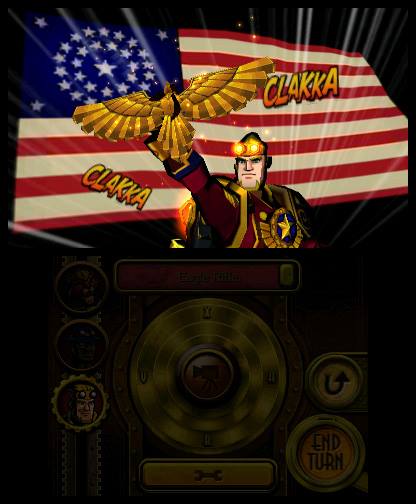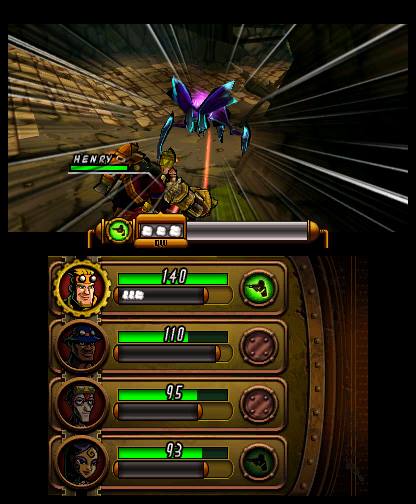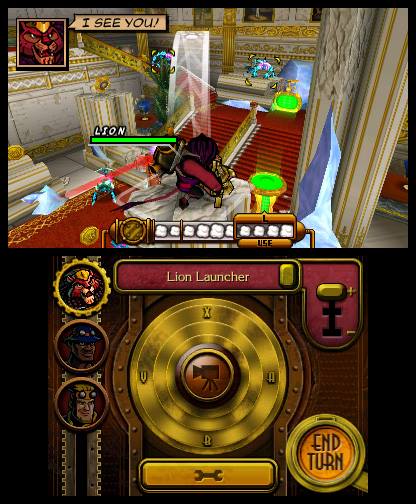Smoke rises across the London skyline. On the deck of the United States Airship Lady Liberty, Tom Sawyer, the Not-so-Cowardly Lion, Tiger Lily (from Peter Pan), and John Henry (“the steel-driving man”) watch as a giant robot modeled after (and piloted by) Abraham Lincoln stomps through the streets, clenching its metallic fists. It squares off against a massive creature, all tentacles and pustules and eyes. This diverse group--white, black, male, female, human, animal--have beaten back the alien menace in the streets, and now it is up to Lincoln to deliver a knockout blow.
I should love this. Code Name: S.T.E.A.M. is a tactical game that teams up folkloric heroes and public domain favorites and sets them against Lovecraftian invaders in a series of turn-based skirmishes. Really, I should love this. But I can’t because Code Name: S.T.E.A.M. squanders all that potential. A combination of design flaws, technical limitations, and narrative missteps renders what should’ve been a memorable game into something utterly forgettable. A world that should be brimming with character and charm is instead dry and flat. Battles that should feel exciting and dangerous are monotonous at best and frustrating at worst.
A world that should be brimming with character and charm is instead dry and flat.

These battles make up the majority of Code Name: S.T.E.A.M.’s 20 or so hours. You fly from fight to fight, watch a cutscene, and then direct a squad of four characters through cities, secret facilities, and other locales. Taking a page from games like Valkyria Chronicles, S.T.E.A.M. gives you real-time, third-person control of your characters, one at a time. You are allotted an amount of “steam” (read: action points) based on the character’s equipment loadout. You spend this steam to move from tile to tile and to attack enemies. Like some other recent tactics games, smart play means setting up chokepoints and utilizing a defensive “overwatch” mode to blast aliens once they move into view. You can also use character-specific special abilities (that come with their own unique animations). The whole thing is great on paper, but developer Intelligent Systems fumbles too much of the execution.
One example: Though the maps are tiled, you can shuffle characters around inside these tiles without spending any additional steam, so if you park Queequeg (yes, from Moby Dick) behind a giant crate with his final steam point, you can still slide him around inside that tile to line up a sneaky shot (on an alien’s glowing weak point, you hope). The problem is that, while you’re manually lining up these attacks, your targets bounce up and down in an idle animation, drifting in and out of your reticle. And since the game only checks to see whether your attack was lined up at the second you pulled the trigger, sometimes you’re left watching your bullets literally pass through an alien, no damage done.
There are other problems, too. Occasionally, an area-of-effect attack or heal might fail to land on one of the targets clearly within its zone of effect. There’s no way to tell whether an enemy is in overwatch mode (this is especially frustrating with a late-game enemy type that is itself immune to overwatch attacks). Then, after spending all that time trying to mitigate these risks, you have to wait for what feels like an eternity for the enemy side to take its turn. Because the view stays locked on your characters, you’re stuck staring at John Henry standing in a corner for 30 to 40 seconds while you vaguely hear aliens moving in the distance. When it’s your turn again, you’re left to swing the camera around wildly, hoping to divine what the hell happened halfway across the map. You have to do this because unlike the aforementioned Valkyria Chronciles, Code Name S.T.E.A.M. never gives you a clear, top-down map view of what’s happening on the field.
While you’re manually lining up these attacks, your targets bounce up and down in an idle animation, drifting in and out of your reticle.

All of this encourages slow, careful play, not because the tactical challenges are tough and need a lot of thought but because an unpredictable and glitchy result can throw your whole plan into disarray at any moment. It doesn’t help that there is very little encouragement to speed through levels or to take interesting risks. With rare exceptions, there is no urgency in Code Name: S.T.E.A.M., just a slow, dreary march forward.
It isn’t just the combat design that’s disappointing. The music is a grating mashup of industrial percussion, thrash guitars, dubstep breaks, and the occasional (and truly out-of-place) flute melody. The maps are boxy and claustrophobic--they all feel like warehouses, even those styled to look like city parks and desert canyons. While your team members are bold, comic-book interpretations of classic characters, the aliens just feel like indistinct blue splotches. Despite their visual flair, even your pulpy heroes begin to wear thin after a dozen hours of hearing the same four or five lines repeated in combat.
At the end of the day, all of this could be forgivable if Code Name: S.T.E.A.M. offered something else special. The best games in the tactics genre do this in a variety of ways. XCOM: Enemy Unknown couples the strong combat missions with a smart strategic layer, but S.T.E.A.M. just ushers you from fight to fight. Valkyria Chronicles has interesting progression mechanics for upgrading your troops and vehicles, but in S.T.E.A.M., your characters never level up or change, and though you can unlock new secondary weapons and “steam boilers” by finding collectibles in the levels, 90% of these are totally inessential. Fire Emblem: Awakening--also available on the 3DS--offers hours and hours of fun interactions with a huge roster of characters. S.T.E.A.M.’s story, on the other hand, is a utilitarian structure: the pre- and post-fight cutscenes are beautifully rendered but give little space for the characters to breathe or interact.
Code Name: S.T.E.A.M. offers the most frustrating kind of steampunk: It brushes up against potent themes, but then turns its back on them in favor of pure aestheticization.

That may be the biggest disappointment of all. Intelligent Systems pulled together an interesting set of figures to star in Code Name: S.T.E.A.M. (including some that were totally new to me, like Califia, the black warrior queen of the mythical island of California). But these aren’t characters, really: They’re just sketches. They’re C-tier Saturday morning cartoon characters. They have great visual design, signature attacks, and a little personality, but that's it.
While it’s incredible to see such a diverse range of characters on screen at the same time, the game is also filled with cringe-worthy stereotypes: the Native American who heals with the power of nature; the Pacific Islander who speaks in broken English; the exotic and mysterious Latina. (And before you say that they’re just staying true to the original depictions of these characters, know that one of them is a gender-swapped Zorro. So no, sorry, they aren’t.) More than anything, though, I wish that these characters had been fleshed out more. If you’re going to put John Henry, Tom Sawyer, and Abe Lincoln on an airship together, please do something interesting with them.
Every now and then, there is a glimmer of something really cool: a throw-away line hints at tension between John Henry and the non-human members of S.T.E.A.M.; a newspaper clipping notes worker revolts springing up around fears of automation; an evocative reference is made to Lincoln’s “fateful day in the theater”--and his survival of those events. These little hints of flavor kept me interested for a while. I was waiting for some big thematic shift or an interesting twist. Unfortunately, it never came. This is just a story of American do-gooders out to save the world with their near-magical technology.
Code Name: S.T.E.A.M. offers the most frustrating kind of steampunk: It brushes up against potent themes, but then turns its back on them in favor of pure aestheticization. When used well, steampunk can be great: Games like 80 Days and Dishonored use steampunk to examine the complexity of emerging technology and massive social change. But in S.T.E.A.M., all we have is American exceptionalism, technological fetishism, and the tiniest dash of diversity training. Yet there is one upside in all this: because all of these characters exist in the public domain, one day, someone will return to this idea. I only hope that they’ll spend a little more time fleshing out the world and its inhabitants. And making a targeting system that works.